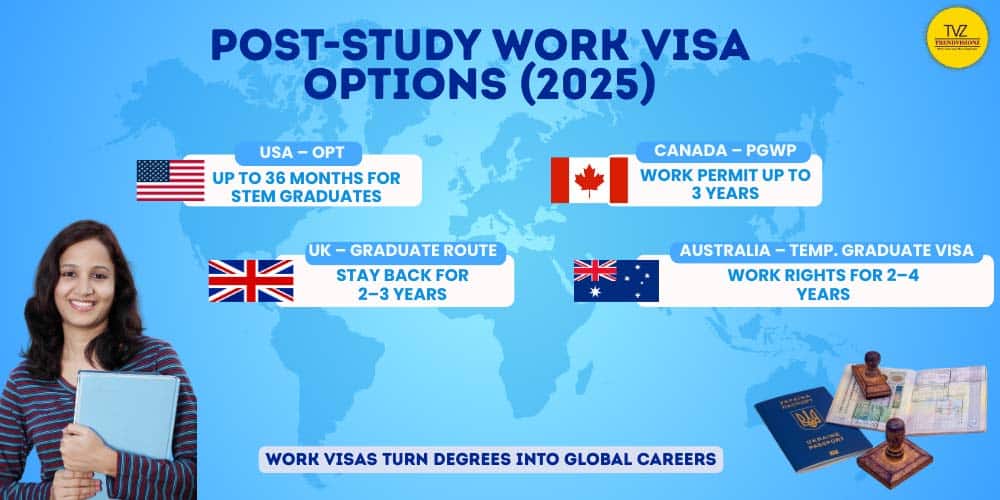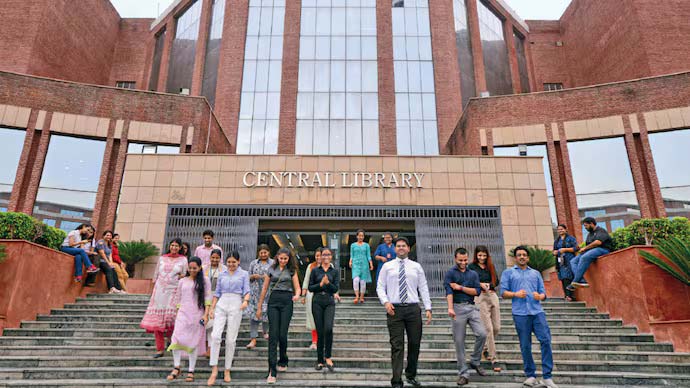When Vandana, a bright student from Meerut, told her parents she wanted to study in Australia, they refused. Financial limits, geographic barriers, and the uncertainty of a new world held them back. She cleared her IELTS, secured a scholarship, and today she is building a career in artificial intelligence. Her journey is no longer rare. Study abroad trends now reflect career goals, not just academic prestige.
For most Indian students, overseas education is about building pathways that lead to international careers, higher earnings, and global mobility. In my three decades of working with young people, I often meet students who ask for guidance and even want me to convince their parents that studying abroad is an investment in their future.
“Study abroad is the single most effective way of changing the way we view the world.” – Chantal Mitchell
This guide, developed in collaboration with my team, aims to simplify the complexities of international education for students and parents. It is backed by my research team and years of experience in international student mobility. We combine data, and insights from the international education sector. The goal is to explain how Indian students are shaping global careers in 2025 and what drives this remarkable shift.
Ready to dive into global education trends transforming Indian students?
Also Read:
- Europe Work Opportunities: Who Leads the New Job Wave?
- PAN 2.0 Explained: How India’s Tax Identity System Is Going Fully Digital
- Global Education Trends: Student Immersion Programs
The Push Factors: Challenges within India’s Education System
The growing number of Indian students overseas in 2025 reflects issues within India’s higher education landscape. With over 1.8 million students overseas this year, international education is being reshaped. These push factors drive families to look beyond borders for better futures.
Limited Seats at Top Institutions: Competition
Every year, millions of students apply for India’s top institutes such as IITs and IIMs. The dream is clear, but the reality is different. Seats are limited, acceptance rates are tiny, and competition leaves many talented students without options.
- IITs and IIMs remain the dream for millions.
- Unfortunately, the number of applicants far exceeds the limited seats available
- Even high scorers miss out due to the sheer competition.
- Families see international education as the alternative.
Outdated Curricula and Employability Gaps
Curricula in many Indian universities remain outdated. Fields such as AI, renewable energy, and data science are missing from large sections of the syllabus.
- A 2022 study highlighted1 that nearly 60% of India’s engineering syllabi were outdated.
- Only 30% of engineering graduates in some states found jobs in their field within a year.
- Employers demand industry-ready skills, but graduates often lack them.
As Bharat Ratna Prof. CNR Rao observed:
90% of the universities in our country have outdated curriculum. We talk about increasing funds, increasing infrastructure but there is no improvement in the content we are teaching in our hi-tech classrooms- Prof CNR Rao, Eminent Scientist
This disconnect pushes students toward global institutions that match industry needs.
Financial Disparities: Brain Drain vs Career Gain
Families weigh salaries in India against opportunities abroad before making choices. The gap is wide across healthcare, IT, finance, engineering, and data science. For many, overseas education is seen as a long-term financial investment rather than prestige.
| Profession | India (Annual Avg.) | Abroad (Annual Avg.) | Destination |
| Nurse | ₹2–3 lakh | CAD 70,000 | Canada |
| IT Professional | ₹6–8 lakh | USD 74,100 | USA |
| Finance Professional | ₹10–12 lakh | USD 100,000 | USA |
| Engineer (Core) | ₹4–6 lakh | AUD 80,000 | Australia |
| Data Scientist | ₹10–15 lakh | EUR 65,000 | Germany |
Such disparities in income drive the debate on brain drain against career gain. Studying abroad is not only about prestige but also a financial strategy for long-term security.
These push factors within the education sector in India explain why more students are leaving. It is less about choice and more about necessity.
The Pull Factors: Why Global Destinations Appeal
Indian students studying abroad are not only pushed out by challenges at home but also pulled toward opportunities overseas. These overseas education trends show why families view study abroad as a career investment rather than only an academic dream.
Flexibility of International Education
One major appeal of study abroad is flexible education systems. Unlike rigid Indian curricula, international universities allow students to choose majors and minors, explore niche courses, and gain industry exposure. This flexibility prepares them for careers in emerging sectors.
- Interdisciplinary learning opportunities
- Research-driven environments
- Tailored academic pathways
Quality Institutions and Innovation
Overseas education trends highlight the global reputation of universities abroad. Higher education institutions across the US, UK, Canada, and Australia remain among the world’s best-ranked. They focus on innovation, technology, and research, giving Indian students an edge in global job markets.
- World-class academic facilities
- Access to cutting-edge labs and research
- Exposure to diverse international faculty and peers not only builds academic strength but also cultural awareness

As Alexander Kolker reminds us,
“Studying abroad is about experiencing a foreign country — and the most beautiful, important part of a country’s culture is its people.” – Alexander Kolker
Career Pathways and Post-Study Work Visas
The strongest pull factor is the link between degrees and careers. The post-study work visa makes the ROI of studying abroad more attractive. Students secure work experience and often long-term residency.
- OPT in the US offers up to 36 months of work for STEM graduates
- Canada’s PGWP allows up to 3 years of post-study employment
- The UK Graduate Route provides 2–3 years of work opportunities
- Australia’s Temporary Graduate Visa extends work rights for up to 4 years

Global universities attract Indian students through flexibility, quality, and clearer academic-to-career pathways. These pull factors ensure that studying abroad delivers not only degrees but also real opportunities for professional and financial growth.
ROI of Studying Abroad: Career Comparisons
Students also calculate the return on investment. Overseas salaries often far exceed those in India, especially in high-demand fields.
| Career Field | Career Field | India (Annual Avg.) | Abroad (Annual Avg.) | Destination Example |
| Data Scientist | Data Scientist | ₹10–15 lakh | USD 110,000 | USA |
| Engineer (Core) | Engineer (Core) | ₹4–6 lakh | AUD 80,000 | Australia |
| Finance Professional | Finance Professional | ₹10–12 lakh | GBP 65,000 | UK |
| Healthcare/Nurse | Healthcare/Nurse | ₹2–3 lakh | CAD 70,000 | Canada |
| IT Professional | IT Professional | ₹6–8 lakh | EUR 65,000 | Germany |
Global universities attract Indian students through flexibility, quality, and clearer academic-to-career pathways. These pull factors ensure that studying abroad delivers not only degrees but also measurable returns and stronger career opportunities.
Changing Student Priorities in 2025
Study abroad trends in 2025 show a clear shift in the way Indian students make decisions. It is no longer only about getting admission into a foreign university. Students and families now evaluate career pathways, ROI of studying abroad, and permanent residency opportunities. These priorities reflect how the international education sector has transformed into a career-focused ecosystem.
ROI and Employability
The first priority is return on investment. Families ask how much a degree will cost and what career outcomes it will unlock. Students prefer courses that link directly to high-demand jobs, internships, and global employers.
- Focus on employability, not only academic prestige
- Demand for internships, co-ops, and job placements
- Clearer alignment between degree and career pathways

Scholarships and Affordability
Affordability is a major concern. Students seek destinations where tuition fees and living costs are balanced by scholarships and financial aid. As Michelle Obama aptly put it,
‘We know that it’s not enough for us to simply encourage more people to study abroad. We also need to make sure that they can actually afford it.’
This perfectly reflects the growing demand for scholarships and cost-effective destinations. Countries like Germany and Ireland are gaining attention for offering quality education at lower cost.
- Rising demand for merit and need-based scholarships
- Preference for destinations with lower tuition fees
- Families comparing overall financial outlay across countries
Cost vs Opportunity (Average Postgraduate Program)
Students compare not only tuition fees but also post-study opportunities. The real value lies in destinations where affordable education aligns with clear pathways to work experience and permanent residency.
- Canada: CAD 20,000 tuition + PGWP → PR pathway
- UK: £20,000 tuition + Graduate Route (2 years)
- Germany: €0–15,000 tuition + PR after work experience
Career Pathways and PR Opportunities
The international education sector is now seen as a direct route to global careers and residency. Post-study work permits and PR pathways weigh heavily in decision-making.
- Canada’s Post Graduation Work Permit. PGWP lets graduates from approved Canadian institutions stay back and build hands-on work experience
- Australia’s Temporary Graduate Visa. Ideal for international students, giving them up to 4 years of work
- Students choose countries that link degrees to long-term settlement

These changing priorities prove that studying abroad in 2025 is not just an academic decision. It is a structured plan where students weigh costs, scholarships, and career pathways before choosing a destination.
Top Study Abroad Destinations in 2025
When Indian students plan their overseas journey, choosing the right country is as important as choosing the right course. The top study destinations for Indian students in 2025 show a mix of traditional hubs and emerging alternatives. These overseas education trends highlight how international student mobility is shaped by costs, scholarships, and immigration policies.

India has become the top country of origin for international students in the U.S.2, with 331,602 Indian students enrolled in the 2023–24 academic year—a 23% year‑over‑year increase – Institute of International Education
The US and UK remain aspirational choices because of academic prestige and globally ranked universities. Yet, high tuition fees and policy uncertainty affect decisions. Families weigh these against more affordable and flexible destinations.
Traditional Hubs: US and UK
- Strong global reputation and alumni networks
- High tuition and living costs
- Visa and immigration rules less predictable

Emerging Hubs: Canada, Australia, Germany, Ireland, New Zealand, Malta
Emerging destinations are gaining popularity because they balance cost with career opportunities. Countries like Canada and Australia provide clear post-study work pathways, while Germany and Ireland offer affordable tuition with growing industries in technology and healthcare.
- Canada’s PGWP provides clear post-study work opportunities and pathways to permanent residency
- Australia grants up to 4 years of post-study work rights
- Germany offers low-cost or tuition-free education at public universities
- Ireland and New Zealand draw students with scholarships and specialized programs
- Malta is emerging as a safe and affordable European destination
Cost vs Opportunity Comparison
Students carefully weigh tuition fees against career opportunities. The true value of top study destinations lies in how education costs align with work visas and pathways to permanent residency.
| Country | Avg. Tution | Post-Study Work Visa | PR Pathway |
| US | USD 30–50k | OPT up to 36 months | Limited, H1-B route |
| UK | £20–38k | Graduate Route 2–3 yrs | PR harder to access |
| Canada | CAD 15–35k | PGWP up to 3 yrs | Clear PR pathway |
| Australia | AUD 20–45k | Temporary Graduate up to 4 yrs | PR accessible |
| Germany | €0–15k | 18-month job-seeker visa | PR after work |
These comparisons show why international student mobility is diversifying. Indian students are now looking beyond the traditional hubs toward destinations that provide affordable education, scholarships, employability, and clear immigration policies.
Career Pathways: From Campus to Career
For Indian students, the real test of study abroad is not admission but what happens after graduation. More than ever, career pathways define success, and those who plan wisely gain the most in the global education marke. Families now make destination assessment based on post-study work visa policies and the ROI of studying abroad.
Post-Study Work Opportunities
Work rights after graduation are a major draw. Students know that a degree should lead to practical experience and, often, permanent residency.
- In the US, STEM graduates can extend their stay through OPT for up to 36 months.
- Canada supports international students with a PGWP that offers as much as 3 years of work experience.
- Australia provides 2–4 years of professional opportunities under its Temporary Graduate Visa program.
- The UK’s Graduate Route grants international students 2–3 years to gain employment after graduation.
These post-study work visa options make international education less risky and more career-focused.
Employers Value International Graduates
For employers worldwide, a degree alone is not enough; they seek broader qualities. They seek adaptability, communication, and problem-solving. Living abroad teaches resilience and cross-cultural skills that Indian students bring back to workplaces worldwide.
ROI Across Fields
The ROI of studying abroad is clear in high-demand sectors.
- Many STEM graduates see their salaries increase twofold when they work abroad
- Healthcare professionals, such as nurses, see salaries five to ten times higher than in India.
- Business graduates access global firms with higher starting pay and faster promotions.
From campus to career, these career pathways show that study abroad delivers more than an education. It creates a launchpad for global mobility, financial growth, and lifelong opportunity.
The Role of Counselling in Study Abroad Decisions
The international education sector has grown complex, and families often struggle to navigate it alone. From admission to visas, scholarships to career alignment, professional counselling is becoming essential. Counsellors act as guides, helping students match ambitions with realistic choices.
Navigating a Complex Journey
Studying abroad involves multiple steps. Universities expect strong applications, embassies require complete visa files, and families want clarity on financial commitments. Counsellors simplify this process by aligning academic records with the right destinations.
- Guidance on admissions timelines
- Support for visa applications and documentation
- Advice on scholarships and financial planning

Bridge Between Aspirations and Career Pathways
Students dream of global careers, but dreams need structure. Counsellors connect overseas education trends with career pathways. They advise whether a course in data science leads to long-term employability or if a healthcare program matches PR requirements.
Demand for Personalised Guidance
The demand for personalised counselling is growing fast. Families no longer want generic advice. They seek expert opinions tailored to their child’s strengths, goals, and financial situation. In this changing landscape, counsellors are trusted partners, ensuring every decision supports long-term success.
When it comes to study abroad trends, career counselling has become essential. It is a vital part of the international education sector, turning the complexity of study abroad into clear and achievable career pathways.
Certification and Credibility in Counselling
In the international education sector, trust is everything. Families invest heavily in study abroad decisions, and they want guidance that meets global standards. This is why certified counsellors are becoming essential.
Why Certification Matters
Certified counsellors bring structure and credibility to the process. They are trained to understand admissions, visas, scholarships, and career pathways. Their advice is not guesswork but rooted in recognised frameworks.
- Transparency in process and decision-making
- Alignment with global best practices
- Higher confidence for students and parents
What are the most popular certifications in study abroad counselling?
Beginner students and families often ask which certifications matter. These globally recognised credentials ensure counsellors provide trusted, professional study abroad guidance.
- CCCIS (Certified Career Counsellor for International Students)
- ICEF Agent Training Course (IATC)
- British Council Certified Education Counsellor
- NAFSA (Association of International Educators) Workshops

A Global Professionalisation Trend
Across the global education market, counselling is moving from informal advice to professionalised services. Certification ensures counsellors can deliver accurate, unbiased information while connecting study options to real career pathways. Families increasingly prefer experts with credentials over unverified agents.
Certification adds trust, improves outcomes, and aligns the international education sector with global expectations. For Indian families, it is a mark of confidence that their child’s future is in safe hands.
Emerging Trends in Study Abroad Guidance
Study abroad trends in 2025 go beyond admissions and visas. The international education sector is shifting with technology, finance, and wellbeing at the centre. These changes reflect wider international student mobility and ongoing international education policy shifts.

- Hybrid Learning and Technology Integration. Universities now combine online and on-campus study, making hybrid learning models mainstream. Hybrid learning models mix online flexibility with on-campus depth for global learners. Technology integrations like Digital classrooms, AI tutors, and VR campuses are now part of the study abroad experience.
- Scholarships and Education Loans. Overseas education comes with high costs, driving student demand for greater assistance. Scholarship prospects are growing, helping students balance costs with access to quality education. The growing demand for education loans reflects families seeking structured financing.
- Skill-Based and Short-Term Programs. Skill-based education and short courses prepare students for industry-ready careers. The popularity of STEM and vocational programs shows how ROI of studying abroad depends on employability, not only prestige.
- Mental Health and Sustainability. Universities highlight mental health support to help international students adapt to new environments. At the same time, sustainability initiatives, from green campuses to eco-focused courses, shape decisions for socially conscious learners.
- Work Opportunities After Graduation. The link between study and career is stronger than ever. Students choose destinations based on work opportunities after graduation, post-study work visa clarity, and long-term pathways to residency.
What is IELTS eligibility for Indian students in 2025?
IELTS eligibility is directly linked to international student mobility. Students often ask how to register, where to take the test, and what it costs when planning study abroad.
- Selecting and booking a test centre: Students can choose from authorised IELTS centres across India or opt for the computer-delivered IELTS. Booking is done online, based on preferred dates and location.
- Choosing institutes and fees: Most universities abroad accept IELTS scores. Fees in 2025 average ₹16,250–₹17,000. Students select institutes at the time of registration or later when sending results.
These emerging trends prove that studying abroad in 2025 is not just about where to study. It is about technology, affordability, wellbeing, and sustainability—all connected to career pathways and global opportunities.
Also Read:
- Recent Cloudbursts in India — Causes and Preparedness
- Citizenship by Investment and Residency: The Rise of Global Indians in 2025
- From Arts to Commerce: How AI in Education Shapes Every Student’s Future
FAQ: Study Abroad Trends
What scholarship prospects exist for Indian students studying abroad in 2025?
Scholarships are expanding across destinations, from merit-based to country-specific options. Germany, Canada, and Ireland are seeing rising offers, making affordability central to study abroad decisions for Indian students in the international education sector.
How do universities support mental health for international students?
Universities now provide wellness centres, counselling services, and peer support groups. Mental health support helps Indian students abroad adapt faster, reducing stress and improving academic focus, while building confidence and resilience in global education environments.
What personal growth do Indian students gain while studying abroad?
Studying abroad builds resilience, adaptability, and cross-cultural skills. Indian students return more confident, with global citizenship values that go beyond academics. It also reframes the brain drain vs career gain debate positively.
What is IELTS eligibility for Indian students in 2025?
IELTS eligibility for Indian students in 2025 remains simple and accessible. There is no age limit, but students must have completed 10+2 education from a recognised board. The test is open to both undergraduate and postgraduate applicants. Universities usually expect a minimum overall band score of 6.0–6.5, though competitive programs may require higher. IELTS continues to be the preferred gateway test for international student mobility across top study destinations worldwide.
Conclusion
Study abroad trends in 2025 prove education is no longer about academics alone. For Indian students, it is about career pathways, financial security, and personal growth.
This student exodus is reshaping the international education sector and influencing policies worldwide. Along with jobs and earnings, studying abroad builds resilience, adaptability, and global citizenship. The future lies in balancing aspiration with affordability and opportunity. Families will continue to view overseas education as both a career strategy and a life-changing experience.
Ready to explore more insights? TrendVisionz audience, share this article in your RSS feed today.
Additional Resources:
- Sudan, Pranav. (2025). The Obsolescence Crisis in Indian CS Education: A Study on Outdated Curriculum and Infrastructure. 10.13140/RG.2.2.28160.34561. ↩︎
- Institute of International Education. (2024). Open Doors Report on International Educational Exchange. ↩︎
Share your Review
Our Digital Imprints:
About the Author: Anuj Mahajan is a Mass Communication Specialist, ICF Certified Coach & Corporate Trainer. Motivational Speaker / NLP Lifecoach. With expertise spanning filmmaking, business coaching, motivational speaking, blog writing, and authoring, he embodies versatility and mastery across diverse fields.
Chief Operating Officer: Nuteq Entertainment Pvt Ltd, and Co-Founder: Trendvisionz – A Premier Digital Marketing Agency in India
Get Connected to us with our Newsletters- Transforming Lives… Creating the magic. Just – Believe ~ Practice ~ Perform BizTech Chronicle… Navigating Tomorrow’s Tech Frontiers 🚀
Join my LinkedIn Group: Digital Marketing, Content Creation World Group
Follow me on Twitter or LinkedIn. Check out my website.
✍️ A Note from the Editor
At TrendVisionz, we craft each article with purpose—guided by research, passion, and the belief that storytelling can spark change. We’ve kept our content open and free for all, because we believe knowledge should never be behind a paywall.
But creating quality digital content takes time, heart, and resources. If this article resonated with you, we’d be deeply grateful for your support. Even $10/month can help us keep producing content that informs, empowers, and uplifts.
💛 Support our work: You can contribute directly via PayPal or email us at anujmahajan@trendvisionz.com to set up your monthly support.
Thank you for believing in independent digital journalism. —Editor




3 comments
I’m often to blogging and i really appreciate your content. The article has actually peaks my interest. I’m going to bookmark your web site and maintain checking for brand spanking new information.
[…] Posts Study Abroad Trends 2025: Indian Students Shaping Global Careers SEO Is Dead? How AI Search Is Evolving User Behaviour Carrectly Auto Care: Revolutionizing […]
[…] career outcomes, financial returns, and migration opportunities. As highlighted by insights on study abroad trends, the global education market is expanding, and Indian students are choosing pathways that combine […]
Comments are closed.